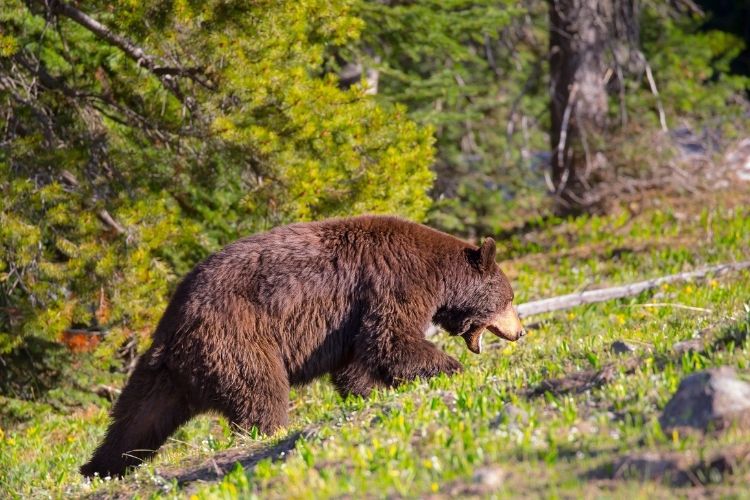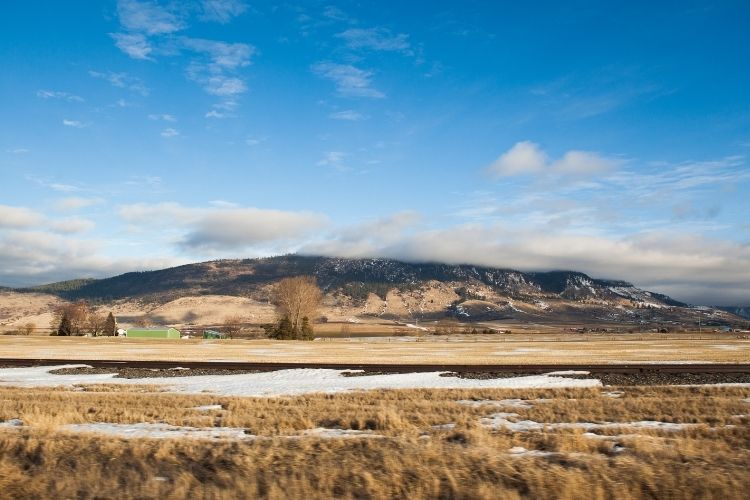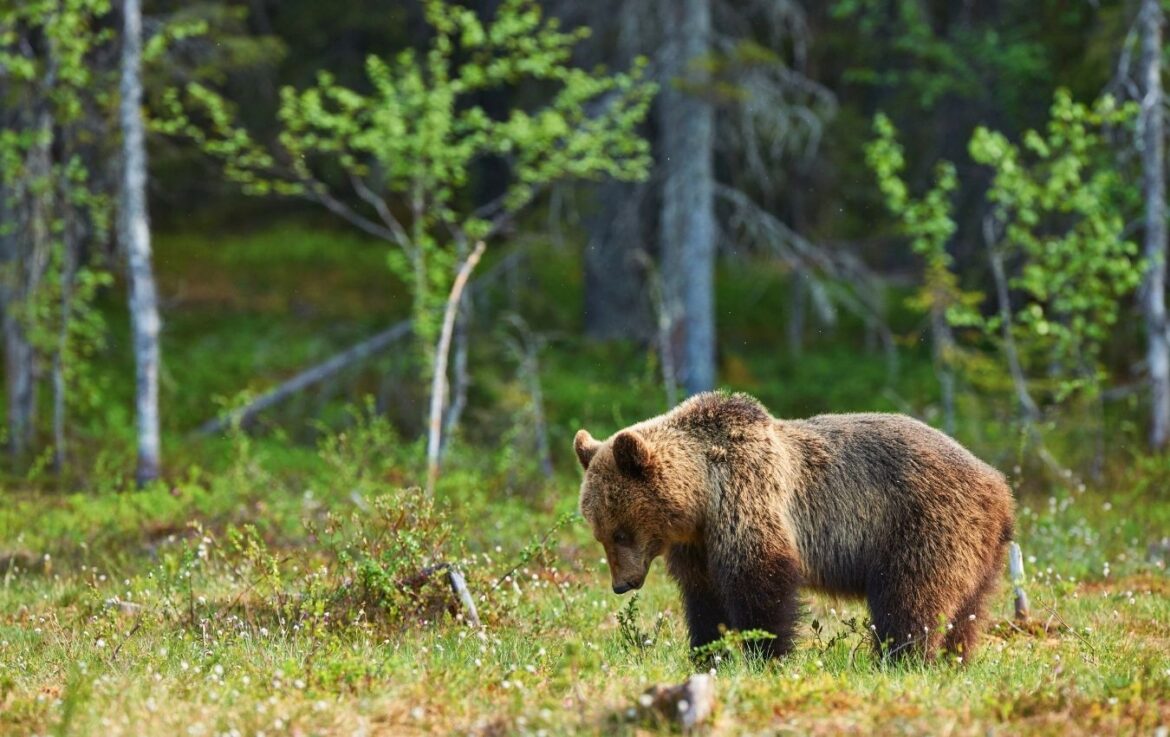Table of Contents
Another bow hunting season
When most of us begin thinking about bow hunting season, our dreams are filled with bugling bulls, golden tamaracks, crisp fall evenings, and majestic mule deer bucks. Seldom do we think of spring wildflowers, bright green meadows, and record book bears.
During the spring bear hunting season, though, the bears are out in the open and quite active. This allows the hunter with more limited resources to have a decent chance at bagging a bear on his own.
During the first few weeks after emergence, bears feed on grasses and forbes, found in open meadows. They are primarily vegetarian, partaking of carrion and fresh kills only if the opportunity presents itself. They feed along the green line, below the receding snows. By carefully glassing meadows and hillsides, bears can be seen feeding lazily in warm spring sunshine. After spotting a legal bear, it’s just a matter of stalking within range of your weapon and abilities.
Calling spring bears

Another method is calling. Since bears will feed on week and defenseless pray, a predator call can be used. Another call, the mouth diaphragm of the type turkey and elk hunters’ use, also works well. It is primarily used to imitate the soft squeal of the calf elk. This is highly effective.
The technique is to hunt slowly, stopping periodically, and calling. Remain where you’re calling from for at least an hour. It gives the bear a chance to locate and move in on your position.
Combining calling and stalking
These techniques can be combined. Years ago while hunting Eastern Oregon’s spring bear season, with bow and arrow, in the Hell’s Canyon country, I cut fresh bear tracks. These tracks led me to a large meadow. I spotted a large cinnamon bear feeding lazily on wild onions.
I attempted stalks from below, then from above. In both cases I ran out of cover, well out of bow range.
After setting up in good hiding cover, I began calling with my mouth diaphragm. The bear refused to cooperate. From seventy-five yards, I resigned myself to sit and watch his antics. It would have been an easy rifle shot, but too long for bow and arrow.
After an hour, the bear began moving. He circled to my right. At about fifty yards he turned and headed straight for me. The bear was coming in head on, with purpose. I realized my option of leaving this bear alone had vanished. At eight yards he stopped, turned broadside, and began feeding on some moss in a young fir tree.
Coming to full draw, the top wheel of my 66 lb. compound bow made a squeak. He whirled to run as my 2117 Gamegetter II arrow zipped past him, landing in a patch of snow. That was the last time I saw that bear.
Grabbing the golden ring

A couple years later I grabbed the golden ring. I drew a tag for the Wenaha unit, in Eastern Oregon. My first day of hunting, I bagged my first bear.
I left Baker City, Oregon around 10:00 a.m. On a previous scouting trip, I had located a couple of good areas overlooking the Grande Ronde River. Pulling up to the overlook of the first area, I began glassing for bears. No more than ten minutes later I spotted a good size, legal bear. He was approximately 1500 ft. below and across the draw from my location. His route of travel would bring him around the hill right underneath me.
Bailing off the mountain side, my plan was to drop to his elevation and set up, out in front for the ambush. Upon arriving at the approximate location, there was no bear insight. Finally I spotted him. He was still across the draw from me, about five hundred feet above, and heading back in the direction he had come from.
I began imitating the squeals of a dying rabbit with my predator call. No sooner had I finished my first round of calls, than the bear immediately turned and headed my way. Since I was in a bad place for the ambush, I looked for a better place. Running across the steep slope I fell hard on a rocky wash, clanging boulders down the hill. Hoping the noise didn’t spook the bear, I continued to search for a good set up. The spot I found wasn’t perfect, but it would have to do, figuring I was running out of time.
After several minutes of periodic calling, I began to wonder if the bear had spooked. Then at twenty-five yards, I saw him. He was below and contouring right underneath me. I knocked an arrow to my string and reached for my predator call, which I had dropped. It had rolled down the hill just out of reach. Fearing I would scare the bear if I moved to retrieve the call, I gave a short whisper quiet whistle with my mouth alone. The bear instantly turned up hill in my direction. He was in heavy alder and hard to see. His route would bring him out into the open just ten yards away. I tried to draw my bow back as he was about to clear the brush, but couldn’t. I had a bad case of the “what the hell do you think you are trying to do” shakes. On my second attempt to draw my bow, the arrow fell off of the string. I manage to catch it with my bow hand, thus preventing it from clanging to the ground. So there we were, the bear just ten yards away, my arrow was not ready to shoot, and I wondered who was going to be hunting whom.
Fortunately I had an ace in the hole. Since you are allowed to use any weapon legal for bear during the spring season in Oregon, I carry a 357 S&W as back up. I really didn’t want to use it, but I didn’t want to miss out on this bear either.
The bear cleared the brush as I pulled the pistol. He heard the cocking of the hammer, turned and took two quick steps back into the brush and stopped. I aimed for a small opening in the alder that covered his vitals and fired.
I waited several minutes and began tracking the bear. My shot had hit home, but this bear wasn’t going to be taken easily. He had gained his feet and headed straight down hill, leaving a trail a novice could follow. The alder was so thick I sometimes had to scoot on my rear down the mountain after him. Twice I heard brush rustling in front of me. It seemed like hours, but finally the bruin couldn’t run any more. I found him lying in the creek, still alive but with no energy left. My eight-year quest for a big canyon bear was over.
Eastern Oregon’s best bet for bears
After hunting bear in the Wenaha and Snake River Units of Eastern Oregon, I believe these areas, especially the Snake River Unit, ranks highly as two of best bear hunting areas in the state. One year after just four days hunting, I spotted seventeen different bears. The extreme ruggedness of this country requires special preparations. Elevations range from 958 ft. at the confluence of the Snake and Imnaha rivers, to 6,982 ft. at Hat Point. It is mostly road less country, and includes the primitive Hell’s Canyon Wilderness and Wenaha Tuchanan Wilderness.
Beware of extreme weather changes. I’ve hunted in 90-degree heat and fresh snow with temperatures in the 20’s.
Also beware of rattlesnakes! Especially in Hell’s Canyon itself. This is a wilderness, and help can be a long time coming.

